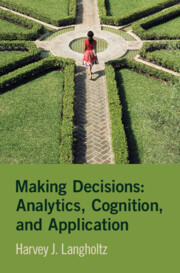Book contents
- Making Decisions: Analytics, Cognition, and Application
- Making Decisions: Analytics, Cognition, and Application
- Copyright page
- Dedication
- Contents
- Figures
- Tables
- Preface
- Acknowledgments
- Copyright Acknowledgements
- Part I Analytics: Probability, Evaluation, Decision Trees, and Strategies for Decision Making
- Introduction to Part II: Cognitive Processes of Decision Making
- Part III Applications, Examples, and Selected Topics
- 10 Signal Detection Theory: How to Detect the Important Signal against the Distracting Background and Take Action as Appropriate Based on the Signal
- 11 Game Theory as Applied to Real-World Decisions
- 12 Decision Making under Stress: Staying Ahead of Rapidly Changing Events and Making Difficult, Time-Critical Decisions
- 13 Decision Making Involving Disputes, Negotiation, and Conflict
- 14 Multi-attribute Utility Decisions: Making Complex and Multidimensional Decisions
- 15 Common Decision Traps and How to Avoid Them
- 16 Overcoming Indecisiveness by Understanding What Causes It
- 17 Looking Back and Looking Ahead: What about Emotion, Culture, Artificial Intelligence, and Intuition?
- References
- Index
- References
11 - Game Theory as Applied to Real-World Decisions
from Part III - Applications, Examples, and Selected Topics
Published online by Cambridge University Press: 23 October 2025
- Making Decisions: Analytics, Cognition, and Application
- Making Decisions: Analytics, Cognition, and Application
- Copyright page
- Dedication
- Contents
- Figures
- Tables
- Preface
- Acknowledgments
- Copyright Acknowledgements
- Part I Analytics: Probability, Evaluation, Decision Trees, and Strategies for Decision Making
- Introduction to Part II: Cognitive Processes of Decision Making
- Part III Applications, Examples, and Selected Topics
- 10 Signal Detection Theory: How to Detect the Important Signal against the Distracting Background and Take Action as Appropriate Based on the Signal
- 11 Game Theory as Applied to Real-World Decisions
- 12 Decision Making under Stress: Staying Ahead of Rapidly Changing Events and Making Difficult, Time-Critical Decisions
- 13 Decision Making Involving Disputes, Negotiation, and Conflict
- 14 Multi-attribute Utility Decisions: Making Complex and Multidimensional Decisions
- 15 Common Decision Traps and How to Avoid Them
- 16 Overcoming Indecisiveness by Understanding What Causes It
- 17 Looking Back and Looking Ahead: What about Emotion, Culture, Artificial Intelligence, and Intuition?
- References
- Index
- References
Summary
Game theory is not what most people think of when we hear the word “game”. Game theory provides conceptual models and logical explanations to describe and predict the decisions rational agents make and the strategies they choose when they interact with other rational agents.
Decisions are often made in an interactive environment where the strategies people adopt, the decisions they make, and the actions they take, are all based on – or are in a reaction to – the decisions of others. This can be true in business, politics, interpersonal relations, and competitive environments. This chapter on game theory includes the most commonly used example in game theory, the prisoner’s dilemma, as well as Nash equilibrium which explains why two or more people in games may often settle on outcomes that are mutually non-optimal. Different types and structures of common real-world games are discussed, including zero-sum games, cooperative and non-cooperative games, tit-for-tat strategy, and social choice theory.
Keywords
Information
- Type
- Chapter
- Information
- Making Decisions: Analytics, Cognition, and Application , pp. 147 - 166Publisher: Cambridge University PressPrint publication year: 2025
References
Recommended Reading
Accessibility standard: WCAG 2.0 A
Why this information is here
This section outlines the accessibility features of this content - including support for screen readers, full keyboard navigation and high-contrast display options. This may not be relevant for you.Accessibility Information
Content Navigation
Allows you to navigate directly to chapters, sections, or non‐text items through a linked table of contents, reducing the need for extensive scrolling.
Provides an interactive index, letting you go straight to where a term or subject appears in the text without manual searching.
Reading Order & Textual Equivalents
You will encounter all content (including footnotes, captions, etc.) in a clear, sequential flow, making it easier to follow with assistive tools like screen readers.
You get concise descriptions (for images, charts, or media clips), ensuring you do not miss crucial information when visual or audio elements are not accessible.
You get more than just short alt text: you have comprehensive text equivalents, transcripts, captions, or audio descriptions for substantial non‐text content, which is especially helpful for complex visuals or multimedia.
Visual Accessibility
You will still understand key ideas or prompts without relying solely on colour, which is especially helpful if you have colour vision deficiencies.
Structural and Technical Features
You gain clarity from ARIA (Accessible Rich Internet Applications) roles and attributes, as they help assistive technologies interpret how each part of the content functions.
